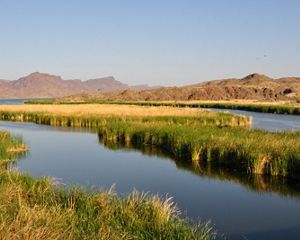Investing in the power of nature can speed recovery after disasters and increase resilience, allowing communities to build back smarter while reducing risk from future storms.
Hurricanes take a large toll on American communities—with lives lost and billions of dollars in physical damage that creates and exacerbates existing infrastructure challenges. Between 1980 and 2016, damages associated with extreme weather cost the U.S. $1.1 trillion. And in the years since then, a number of disasters—hurricanes Harvey, Irma, Maria, Florence and Michael, flooding in the Great Plains and Midwest and catastrophic wildfires in the West—have caused billions of dollars more of devastation.
Increasingly intense storms and a changing climate make the need for resilient communities even more urgent.
Investing in federal programs to mitigate risk in advance of storms, especially by implementing natural infrastructure solutions, is a cost-effective approach that also meets growing infrastructure demands. Whether used alone or with gray infrastructure, nature-based solutions like wetlands, living shorelines and oyster reefs have been proven to generate significant economic and protection benefits, as well as avoid financial losses for coastal communities.
In addition to stimulating local, state and national economies by creating new jobs, natural infrastructure plays an important role in safeguarding communities by reducing the overall impact of hurricanes—minimizing the extent of post-disaster cost and recovery efforts.
Federal disaster aid for hurricanes Harvey, Irma and Maria should incorporate natural and nature-based solutions to expedite recovery while increasing resilience. Investing in programs that enable communities to build back smarter while also mitigating for future storms is essential to making—and keeping—these communities whole.
Natural Infrastructure Benefits
Storm Protection: A healthy coral reef can reduce wave energy by up to 97%. Coastal wetlands provide storm protection valued at $23.2 billion per year in the United States.
Economic: Funds received by the National Oceanic and Atmospheric Administration from the American Reinvestment and Recovery Act in 2009 for coastal restoration supported on average 15 jobs per $1 million spent and up to 30 jobs per $1 million spent on labor-intensive projects.
For example, coastal wetlands prevented more than $625 million in property damages during Hurricane Sandy and reduced property damages throughout the Northeast by 10% on average. In New Jersey, wetlands saved more than $425 million in property damages.
Funding Priorities: Disaster Supplemental for Hurricane Recovery
Adequate funding must be provided in disaster aid supplementals to ensure community recovery and avoid forcing programs to redirect regular appropriations to cover shortfalls.
Priority programs include the following:
National Oceanic and Atmospheric Administration
- Funding should restore habitat and facilities damaged by the storms to ensure delivery of natural resource management missions.
- Fund the design, implementation and monitoring of coastal resilience projects.
- Priority programs include the following:
- Coastal resilience grants.
- Fisheries disaster relief.
- Marine Debris Program.
- Coral Reef Conservation Program.
- National Estuarine Research Reserves and National Marine Sanctuaries.
- Conservation Corps.
- Mapping and charting.
- Science and technical assistance.
- Make a portion of funding available through competitive awards as was done after Sandy.
Department of the Interior
- Provide funding to rebuild and restore facilities and habitat managed by the agency that were damaged during the hurricanes.
- Invest in conservation and restoration work on public lands to enhance resilience. After Sandy, $360 million was made available to achieve this, and a similar effort should be included in this aid package.
Army Corps of Engineers
- Conduct a study like the North Atlantic Coast Comprehensive Study for the south Atlantic and Gulf coasts of Florida and Texas, as well as for Puerto Rico and the U.S. Virgin Islands. Prioritize funding for the south Atlantic study authorized in the Water Resources Development Act 2016 and expand similar studies to the Gulf and Caribbean.
- Encourage use of nature-based solutions, and enhance resilience in post-storm projects.
Environmental Protection Agency
- Incorporate natural infrastructure into State Revolving Fund investments to repair and rebuild wastewater and drinking water facilities in impacted areas.
- Increase funding for Clean Water Act section 319 grants to reduce pollution and reduce flood risk, particularly in urban areas.
- Provide additional funding for the Water Infrastructure Finance and Innovation Act federal loan program for water and wastewater infrastructure projects in response to disasters.
Department of Agriculture
- Direct funds in a manner similar to what was done after Sandy, allowing for urban buyout programs and restoration of land to a natural, flood-resilient state.
Federal Emergency Management Agency
- Maximize the Hazard Mitigation Grant Program.
- Provide funding to help communities invest in risk reduction efforts, including buyout programs. Expedite a portion of these funds to be spent sooner than a year post-disaster to provide communities access to the full range of recovery options without delay.
Department of Housing and Urban Development
- Invest a significant portion of the Community Development Block Grants for disaster recovery to set up a Rebuild by Design Competition similar to that created after Sandy that can facilitate investments in resilience including use of natural infrastructure to reduce flood risk.



